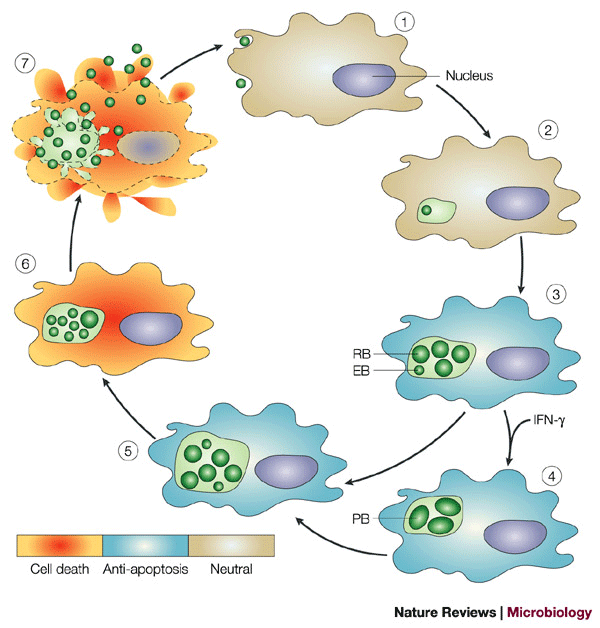Disease Specifics
Chlamydia pneumoniae infection is a type of atypical bacterial pneumonia that is characterized by relatively long incubation periods (3 to 4 weeks) and a wide spectrum of clinical symptoms. The varied clinical presentation and lack of standardization for diagnostic methods available present unique challenges for accurately identifying C. pneumoniae cases and appropriately treating patients.
Since C. pneumoniae infection is likely underdiagnosed, the actual number of cases each is unknown. However it is estimated 300,000 cases of C. pneumoniae infection occur annually in the United States. Primary infection occurs mainly in school-aged children or young adults, while reinfection is most common in older adults. Persistent reinfections are a risk factor for chronic infection.

Reprinted by permission from Macmillan Publishers Ltd: Bryne GI, Ojcius DM. Chlamydia and apoptosis: life and death decisions of an intracellular pathogen. Nature Rev. Microbiol. 2004. 2(10):802–8.
Chlamydia pneumoniae
C. pneumoniae (formerly called Chalmydophila pneumoniae), along with Chlamydia psittaci and Chlamydia trachomatis, are members of the bacterial family Chlamydiaceae. The Chlamydiaceae family shares a unique developmental cycle that is different from all other bacteria. C. pneumoniae growth consists of two alternating forms: elementary and reticulate bodies. Elementary bodies are metabolically inactive. They infect the host by being ingested into the cell (receptor-mediated endocytosis). Once inside the cell, the elementary bodies differentiate into reticulate bodies, which are metabolically active but noninfectious. The reticulate bodies, which rely on the host cell for adenosine triphosphate (ATP) synthesis, divide by binary fission and induce a host immune response. After 48 to 72 hours, the reticulate bodies reorganize themselves and condense to form new elementary bodies. The elementary bodies then leave the host cell and start a new infectious cycle. Since C. pneumoniae growth takes place within host cells, culture requires growth within eukaryotic cells rather than on cell-free culture media.
Pathogenesis
C. pneumoniae only causes illness in people and cannot survive outside its host for very long. For this reason, C. pneumoniae is transmitted from close person-to-person contact by airborne droplets. Someone with C. pneumoniae infection may also contaminate their hands by coughing on them; others can become infected by touching the hands of an ill person and then touching their own nose or mouth.
In the past 20 years, a wide variety of diseases have been linked to C. pneumoniae including atherosclerotic cardiovascular disease, multiple sclerosis, asthma, age-related macular degeneration, Alzheimer’s disease, chronic fatigue syndrome, and chronic skin wounds. However, a causal relationship between these diseases and C. pneumoniae infection has not been confirmed.
References
-
Blasi F, Tarsia P, Aliberti S. Chlamydophila pneumoniae. Clin Microbiol Infect. 2009;15:29–35.
- Burillo A, Bouza E. Chlamydophila pneumoniae. Infect Dis Clin N Am. 2010;24:61–71.
- Cunha BA. The atypical pneumonias: Clinical diagnosis and importance. Clin Microbio Infect. 2006;12:12–24.
- Kuo CC, Jackson LA, Campbell LA, Grayston JT. Chlamydia pneumoniae (TWAR). Clin Microbiol Reviews. 1995;8(4):451–61.
- Page last reviewed: September 26, 2016
- Page last updated: September 29, 2016
- Content source:


 ShareCompartir
ShareCompartir